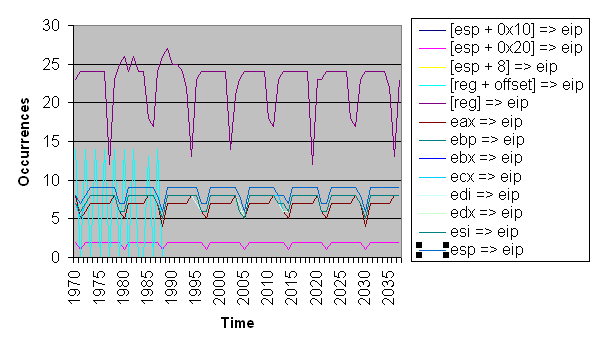

| Current | v9 | v8 | v7 | v6 | v5 | v4 | v3 | v2 | v1 | All | About |
Case study: Example application
Aside from Windows' processes having SharedUserData present, it may also be possible, depending on the application in question, to find other temporal addresses at static locations across various operating system versions. Take for instance the following example program that simply calls time every second and stores it in a local variable on the stack named t:
#include <windows.h>
#include <time.h>
void main() {
unsigned long t;
while (1) {
t = time(NULL);
SleepEx(1000, TRUE);
}
}
When the telescope program is run against a running instance of this example program, the results produced are:
C:\>telescope 3004 [*] Attaching to process 3004 (5 polling cycles)... [*] Polling address space........ Temporal address locations: 0x0012FE24 [Size=4, Scale=Counter, Period=70 msec] 0x0012FE88 [Size=4, Scale=Counter, Period=1 sec] 0x0012FE9C [Size=4, Scale=Counter, Period=1 sec] 0x0012FF7C [Size=4, Scale=Epoch (1970), Period=1 sec] 0x7FFE0000 [Size=4, Scale=Counter, Period=600 msec] 0x7FFE0014 [Size=8, Scale=Epoch (1601), Period=100 nsec]
Judging from the source code of the example application it would seem clear that the address 0x0012ff7c coincides with the local variable t which is used to store the number of seconds since 1970. Indeed, the t variable also has an update period of one second as indicated by the telescope program. The other finds may be either inaccurate or not useful depending on the particular situation, but due to the fact that they were identified as counters instead of being relative to one of the two epoch times most likely makes them unusable.
In order to write an exploit that can leverage the temporal address
t, it is first necessary to take the steps outlined in this
document with regard to calculating the duration of each byte index
and then building a list of all the viable opcode permutations. The
duration of each byte index for a four byte timer with a one second
period are shown in figure ![[*]](images/html/crossref.png) .
.
| Byte Index | Seconds (ext) |
|---|---|
| 0 | 1 (1 sec) |
| 1 | 256 (4 mins 16 secs) |
| 2 | 65536 (18 hours 12 mins 16 secs) |
| 3 | 16777216 (194 days 4 hours 20 mins 16 secs) |
The starting byte index for this temporal address is byte index one
due to the fact that it has the smallest feasible window of time for
an exploit to be launched (4 mins 16 secs). After identifying this
starting byte index, permutations for all the viable opcodes can be
generated. All the permutations from 1970 to 2038 are shown in
figure ![[*]](images/html/crossref.png) .
.
Nearly all of the viable opcode windows conveyed in figure
![[*]](images/html/crossref.png) have a window of 4 minutes. Only a few have
a window of 18 hours. To get a better idea for what the future has
in store for a timer like this one, table
have a window of 4 minutes. Only a few have
a window of 18 hours. To get a better idea for what the future has
in store for a timer like this one, table ![[*]](images/html/crossref.png) shows
the upcoming viable opcode windows for 2005.
shows
the upcoming viable opcode windows for 2005.
| Date | Opcode Group |
|---|---|
| Fri Sep 02 01:28:00 CDT 2005 | [reg] => eip |
| Thu Sep 08 21:18:24 CDT 2005 | [reg] => eip |
| Fri Sep 09 15:30:40 CDT 2005 | [reg] => eip |
| Sat Sep 10 09:42:56 CDT 2005 | [reg] => eip |
| Sun Sep 11 03:55:12 CDT 2005 | [reg] => eip |
| Tue Sep 13 10:32:00 CDT 2005 | [reg] => eip |
| Wed Sep 14 04:44:16 CDT 2005 | [reg] => eip |
